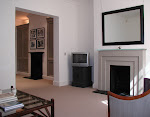Thousands of gallons later I am still a great supporter of Papers & Paints' Not Totally White. The milky emulsion allows a feeling of crisp cleanliness while preserving a hint of warmth. The perfet canvas for layers of subtle interior design. But England's tradition in wall papers is such that they never make a complete exit from the trendy magazines. The weather calls for an illusion of warmth in this country and lath & plaster walls - specially typical of London's historic houses, can always do with an extra little bit of "help". Logic is never far behind good interior design choices. So where to source your papers if you have time only for a couple of pit stops? Cole & Son (I am still waiting for a chance to use one of the Fornasetti  papers). Recently I have discovered the smart and understated collections by Phillip Jeffries. Check out the linens: trendy and timeless is a difficult combination to achieve and Leo's Luxe Linens do it for me. Adding warmth in the Winter yet looking suitably fresh in the Summer, linen is a winner once again in my book.
papers). Recently I have discovered the smart and understated collections by Phillip Jeffries. Check out the linens: trendy and timeless is a difficult combination to achieve and Leo's Luxe Linens do it for me. Adding warmth in the Winter yet looking suitably fresh in the Summer, linen is a winner once again in my book.
 papers). Recently I have discovered the smart and understated collections by Phillip Jeffries. Check out the linens: trendy and timeless is a difficult combination to achieve and Leo's Luxe Linens do it for me. Adding warmth in the Winter yet looking suitably fresh in the Summer, linen is a winner once again in my book.
papers). Recently I have discovered the smart and understated collections by Phillip Jeffries. Check out the linens: trendy and timeless is a difficult combination to achieve and Leo's Luxe Linens do it for me. Adding warmth in the Winter yet looking suitably fresh in the Summer, linen is a winner once again in my book.


 The crinkled silk like dark fabric from
The crinkled silk like dark fabric from 
 matching tieback (part of the 2009
matching tieback (part of the 2009 








 In an earlier post you saw a
In an earlier post you saw a  These should give an idea of how a limit on budget does not have to result in a limit on good taste. Stick to your "simplicity" rule across the board. When it comes to fabrics make plainess and budget inversely proportional: the smaller the first the plainer the second! See the board below:
These should give an idea of how a limit on budget does not have to result in a limit on good taste. Stick to your "simplicity" rule across the board. When it comes to fabrics make plainess and budget inversely proportional: the smaller the first the plainer the second! See the board below:  plain fabrics can be of a lesser quality and the difference will hardly be noticeable while patterned fabrics need to be better quality.
plain fabrics can be of a lesser quality and the difference will hardly be noticeable while patterned fabrics need to be better quality.  Through that sketch and photograph the client was able to agree the design and issue his instructions.
Through that sketch and photograph the client was able to agree the design and issue his instructions.  The kitchen, nearly completed, was photographed today.
The kitchen, nearly completed, was photographed today. As you will see the
As you will see the 



